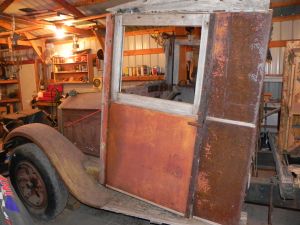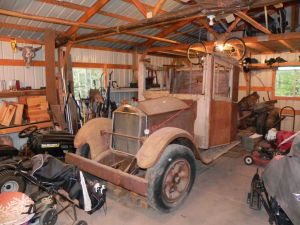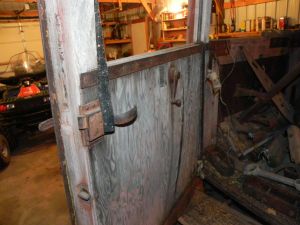- Home
- About Us
- Join/Renew
- Member Benefits
- Member Pages
- Log In
- Help
- Museum Store
Weird thing is there are not holes in the chassis. Here are some more clarifications on the measurements to muddy things up even more.
This is from the end of the frame.
It doesn’t look like the pictures came through, let me know if you can see them. I may need to delete some of these or start a new thread.
Here is a photo showing the dash is at 197″ which is what the specs show.”
Sorry for the confusion and rambling on but apparently I cant send PDF files, only photos. Here is another one showing the distance of 148″ from the back of the cab/seat to the end of the frame which is also as specified in the FA Truck Specifications.”
Peter,
I’m starting to think that someone modified the location of the front of the cab only. Comparing mine to the other truck it appears everything is in place except the cowl is missing and front of the cab is further forward. Weird thing is that the (Dash to back of seat = 49″) measurement is correct. If you measure from the front of the dash once the cowl is installed then the measurement wouldn’t change but I am not sure if that is the correct. This would of course shorten the overall length of the cab so it doesn’t seem right either. UGH???”
try the picture again.
Last try
Charles, I’m thrilled Paul was able to provide you data to keep this very unique project going in the right direction.
Please keep posting!
John
Hi Charles, I think that the cab was modified to have wider doors, or no doors.
The hood is the correct length, so the firewall is in the right place.. Since the engine and radiator are rigidly mounted to the chassis, there is no easy, or even difficult way to move the cab forward, unless the firewall was cut to overlap the rear of the engine, a Series 80/81 firewall is only about 1/4″ behind the engine cylinder block.
As for making the cab over again, First, come get this cowl from me, I’m located in south east Michigan, at exit 98 on I-75. About 15 miles south of Flint, or the intersection of I-69/US23/I-75.
The cost of the cowl is really high: you will need to bring additional photos, and spend the night, so we can talk cars till we can’t stay awake,, That’s it.
The cowl is in pretty good shape, it does have some perforating rust holes, in the lower 3″ of the sides, were the cowl would bolt to the sill plate, with the angle brackets just inside,
The rust in this location is common, the wet feet of the driver would leave the area around the pedals damp, promoting rust in the cowl, where it touches the wood sill of the body.
My guest room is not 5-star, more like 3-star, but it’s clean, and has it’s own facilities. You are welcome to stay, and see my collection of cars and parts, it is affectionally known as ‘Long’s Folly in Holly.”
For the reconstruction of the cab, you will need to get some straight white ash, reconstruct the sills, they are 2″ thick and about 7-8″ wide, and run from the firewall to the back rear corners of the cab. Then the vertical pieces that will be the door frame need to be made, so you need to find some doors, or door skins to use as patterns,, I might just have some doors too, I’ll have to dig deeper into the piles of cars and parts.
If you are going to make the cab without doors, then the desire for door patterns is moot. you will want a windshield frame to use to determine the height of the cab’s roof.
All of the above is actually pretty easy, as reconstruction goes, since there are very few curves, and no compound curves.
Use email or a phone call or text to contact me regarding setting up your trip to pick up your free parts..
Show us a photo of that instrument panel, that was mounted upside down..
Greg Long
Just my 2 cents worth. As the son of an 1920’s/30s trucker—- It was common on trucks of the era to NOT have a cowl & to have the windscreen in line with the firewall. Have a quick look at the Pierce Truck adverts from around 1920. There are a few on eBay at the moment for reference. Also trucks sold as chassis only & then a coachbuilder did the rest. No doors were also common. It was NOT the done thing to give the EMPLOYED driver too much comfort—especially if the truck was used for short haul work where the driver had to get out & in at short intervals. Doors were a nuisance! This persisted even into the 1950,s. I would say that your truck with the w/screen at the firewall is as it was made originally.
Greg,
Thanks for all the great information and invite into Longs Folly in Holly. Im not sure when but I am going to get there sometime. Unfortunately I need to show up at the office during the week and have basketball and softball seasons to watch my last daughter who is now a senior in high school play. I will most likely give you a call sometime in the near future to discuss more details. In the meantime here are some more pictures of my truck before I started to dismantle it.

I do have most of the wood for patterns and both doors.

Here is a drawing I put together to remind me of how to rebuild it.
Jake, thanks for speaking up. My father was here again just today and he swears that it was built like this from the factory. Or should I say the Coachbuilder. It was well put together with mortise and tenon joints and what appears to be factory Steel Corner Supports.
My father is 76 yrs old and bought the truck when he was around 19. He did nothing but drive it for a few years then park it.
Here is a picture of the upside down dash, at least according to the parts manual.
My dad said the drivers window opened, which you can see how in this photo, but the passenger window was stationary.
Jake, have you seen any trucks that look similar to mine, meaning the steel plate on the firewall and wood look? There is steel wrapped around the back cab corners and on the doors but no where else.
Also, notice the plywood on the doors and the interior.

